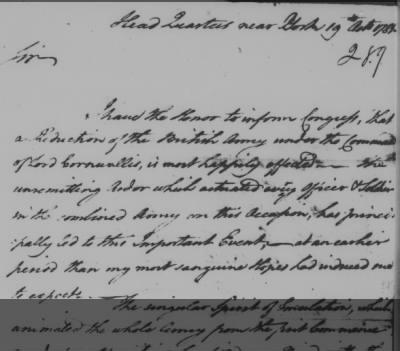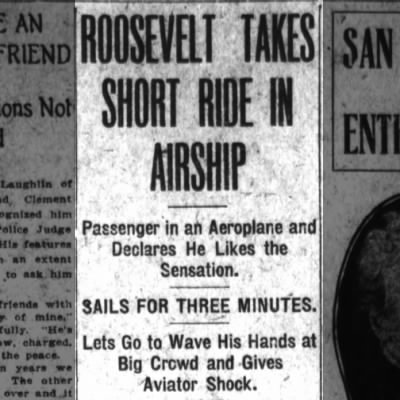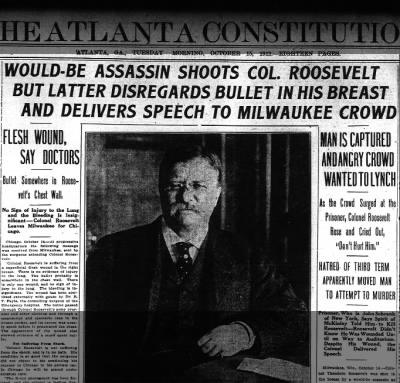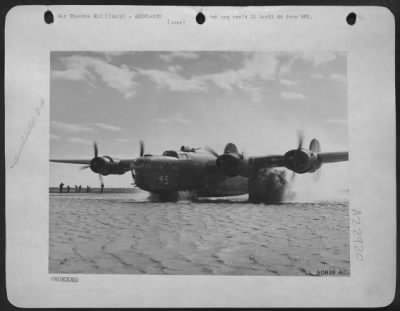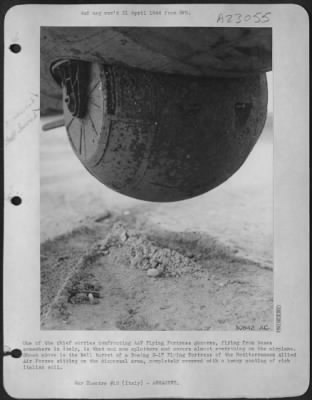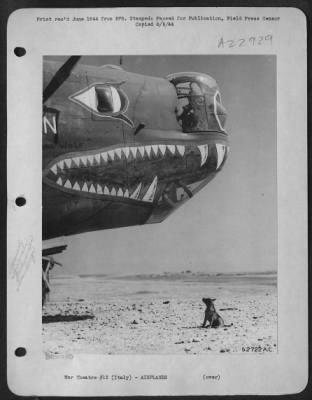March 22, 2011
Teddy v 50 Cent
Historically a bit inaccurate as we learned in this post, but very clever all the same.
October 19, 2010
Washington Reports The Surrender at Yorktown
Here's a letter that General Washington wrote to tell congress about the victory, from The Papers of the Continental Congress on Fold3:
October 14, 2010
They Don't Make Them Like Teddy Anymore

It's always seemed like he may have benefited from the tendency toward recentness in "best of" lists. But, this week I ran across two stories from Octobers past that are starting to change my mind. In fact, if I keep finding things like this I may rename this blog, "The Roosevelt Chronicles."
Story #1: Teddy's First Flight
On 11 October 1910, just a few years after the Wright Brother's first successful heavier-than-air human flight, while visiting a flying exhibition in St Louis, Roosevelt was invited to take a ride with Archie Hoxsey, a Wright aviator. Roosevelt accepted the invitation, hopped into the plane (well, OK, as this video on the Library of Congress website shows, he struggled his way through all the lines and guy-wires that held the thing together) and took a couple of loops around the field.
While in the air, Roosevelt was so excited and waved so enthusiastically to the crowd that "Hoxsey was afraid he would fall out or interfere with the engine, which was roaring at his side," and had to shout to tell "the Colonel" to calm down.
The crowd was stunned silent during the flight, but erupted into cheers once the plane landed.
When the flight was over and Roosevelt was on the ground again, he shook Hoxsey's hand vigorously and said, "It was great! First class! It was the finest experience I have had. I wish I could stay up for an hour, but I haven't the time this afternoon."
Story #2: Roosevelt, Shot While Campaigning, Gives Speech with Bullet in Chest
While on his way to a campaign speech in Milwaukee on 14 October 1912, Roosevelt was shot in the chest by John Schrank who apparently didn't like the idea of Roosevelt running for a third term.
The assailant was subdued and brought to Roosevelt who asked him to explain himself. When Schrank didn't reply, Roosevelt headed off to the auditorium and spoke for an hour and a half.
Following his speech, Roosevelt, "weak from loss of blood," was taken to the hospital where an x-ray revealed the bullet lodged near his lung.
July 20, 2010
The 20 July Plot
For years, officers of the German military had been conspiring to overthrow Hitler and other assassination attempts had been made, but the 20 July plot seems to have been the most elaborate and well thought out.
The plot has inspired several books and movies, including the 2008 film Valkyrie which stars Tom Cruise as Count Claus von Stauffenberg, the man who planted the bomb intended to blow up Hitler and then returned to Berlin to help with the coup that was to follow.
The WWII Foreign Military Studies on Fold3 include some interesting information about the 20 July plot including...
A description of the plot by Otto Ernst Remer, leader of the home guard units that helped put down the coup attempt:



This YouTube video provides a brief overview of the events and this one includes the audio of the speech Hitler gave after the attempt on his life. You can see some pictures and learn all sorts of details from this Wikipedia page.
May 6, 2010
Free Access to Historical Newspapers
Fold3 has opened up access to their historical newspapers for the month of May. You'll have to register to see some of them, but it's free.
Historical newspapers are full of entertaining, informative and downright strange things.There are some great newspapers on the site. A few of my favorites are:
The Times (London) 1785-1820; 1860-1865; 1914-1919
The Times provides a great perspective on world and US events. You can browse by date here or read more and search here.
The San Francisco Chronicle (California) 1865-1923
This is a great paper that manages to combine a frontier feel with in-depth reporting on local, national and world issues. Browse or learn more.
The Atlanta Constitution (Georgia) 1868-1923
The Constitution provides a unique, southern viewpoint. Browse or learn more.
The Chicago Tribune (Illinois) 1829-1943
A great newspaper for a northern and mid-west perspective, but they did a great job reporting national and world news as well. Browse or learn more.
April 15, 2010
Tax Day
The 16th Amendment to the US Constitution was passed by the 61st Congress on July 12, 1909 and ratified by 2/3 of the states February 3, 1913.
Here's the 1040 form for 1913:
February 16, 2010
WWII in Italy: Flooded Airfields, Muddy Ball Turrets and Dragons
Here's a picture of an airfield in Italy that was flooded after some heavy rains.
The muddy landing strips made the ball turret gunner's life even less pleasant:
While we're in the area, he's some great nose art on a B-24 Liberator:
The dog doesn't seem to know what to make of it.
February 4, 2010
War: Bringing People Together
!["Naga Headhunters [Learn] To Cut Hair"](http://img8.footnote.com/img/thumbnail/46942878/400/400/608_607_2776_2601.jpg)
I don't know anything about any of the people in this picture, but when I read the caption,
"In Addition To His Other Duties, Pvt. Morris Glieberman Of New York City Was Barber For The Yank Expedition. Here, He Teaches Naga Headhunters To Cut Hair, Using Pfc. Jack Elston Of Salt Lake City, Utah As The Victim."I couldn't help but think, "So, a Mormon, a Jew and a headhunter walk into this bar[bershop]."
January 12, 2010
Miep Gies Dies at Age 100
 Miep Gies
Miep Gies15 February 1909 – 11 January 2010
Miep Gies, who helped Anne Frank and her family avoid capture by the Nazis for more than two years and safeguarded the young Holocaust victim's famous diary for posterity, has died at age 100.From CNN.com:
Gies was among a team of Dutch citizens who hid the Frank family of four and four others in a secret annex in Amsterdam, Netherlands, during World War II... She worked as a secretary for Anne Frank's father, Otto, in the front side of the same Prinsengracht building.
The family stayed in the secret room from July 1942 until August 4, 1944, when they were arrested by Gestapo and Dutch police after being betrayed by an informant. Two of Gies' team were arrested that day, but she and her friend, Bep Voskuijl, were left behind -- and found 14-year-old Anne's papers.
From BBC.co.uk:
It was Mrs Gies who collected up Anne's papers and locked them away, hoping that one day she would be able to give them back to the girl.In the event, she returned them to Otto Frank, who survived the war, and helped him compile them into a diary that was published in 1947.
... "We did our duty as human beings: helping people in need."
January 11, 2010
Survivor of Two Atomic Bomb Blasts Dies at Age 93
Sometime last year, while I was looking through the World War II Air Force photos collection and doing some research on those first atomic bombs, I came across this 2005 article by Richard Lloyd Parry who interviewed Mr Yamaguchi along with his coworkers and fellow survivors Akira Iwanaga and Kuniyoshi Sato (there is a slightly shorter version republished in March of 2009 with a couple of photos here.) Parry explained that,
"In 1945, they were working in Hiroshima, where the world's first atomic bomb exploded on August 6... One hundred and forty thousand people died as a result of the explosion; by chance, Mr Yamaguchi, Mr Sato and Mr Iwanaga were spared. Stunned and injured, reeling from the horrors around them, they left the city for their home town, Nagasaki, 180 miles to the west. There, on 9th August, the second atomic bomb exploded over their heads."These survivors' descriptions of the scenes during and after the bombings are vivid and shocking and provide a powerful reminder of just how terrible a weapon an atomic bomb is.
Some of the photos of the aftermath of the atomic bomb blasts at Hiroshima and Nagasaki have a similar effect:
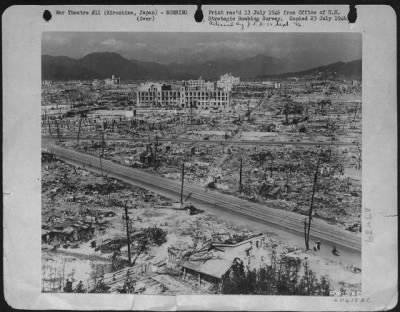
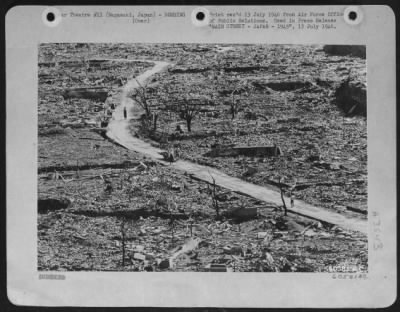
Nagasaki: "A street through a formerly congested residential area... 1,000 ft. northeast of atom bomb burst."


